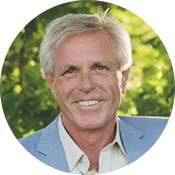Tom Myers has dedicated his life to healing people through the power of touch. He has practiced integrative manual therapy, which includes massage and Rolfing, for over 40 years, and is the author of the book Anatomy Trains. Parvati Magazine’s Yoga Editor Ella Isakov interviews Tom about fascia, movement and healing.
Parvati Magazine: Let’s start with fascia. It seems to be a word everyone in the yoga community is talking about lately. What is it and what does it have to do with hatha yoga?
Tom Myers: The fascial system holds 70 trillion wet cells together by weaving the cells into strong pliable nets of collagen. Your tendons, ligaments – all the “tough stuff” – are predominantly made out of collagen.
Yoga plays a big part in maintaining healthy fascia, as it is a way of rehydrating the body tissues, so they will slide and glide into movement. Hydration is a matter of water filling in all the tissues. That is a matter of “squeezing the sponge” of those tissues, and that’s what yoga does – systematically and with increasing challenge as you become more adept. Many approaches to hatha yoga are designed to open the water mains in the body and irrigate the entire crop of cells – muscles, nerves, and the many surfaces of epithelia.
PMAG: Does fascia affect the mind or emotions?
TM: I doubt very much that fascia contributes directly to mental ability or emotional stability, but emotional instability projects or discharges into the body as muscular tension. The muscular tension puts the “knots” in the fascia, which leads to the downward spiral of dry and ineffective areas within muscles, joints, and even organs. As we open these tissues, we have the chance to “remake” those emotional instabilities. So work on the fascia – through bodywork, osteopathy, or yoga – can open the tissues to make way for an inner state change that would be difficult if the tissue were dry and gluey.
PMAG: When we practice yoga with poor technique, the body will eventually assert itself to let us know that we must change our ways to support healthy movement. What fascial connections do yoga practitioners need to know that will help prevent injury and enable healthy movement?
TM: The most important part of injury prevention in yoga is to move slowly. Dry tissue can tear if moved too quickly or too strongly. With sufficient patience, even the driest tissue will hydrate, expand, and begin to glide on its surroundings.
PMAG: Can you briefly describe how myofascial manipulation can help with stress, past trauma (stored emotions) and physical pain?
TM: Whatever pain you may be aware of at any given moment, far more pain is “stored” in the inert tissues. You begin to feel that “sweet pain” as you stretch beyond your common sphere of movement. Yoga is not the only way to achieve this, but it is a highly organised and developed way of finding your whole self. And your whole self makes better decisions – on a physiological level, and consequently on an emotional and developmental level as well.
PMAG: Based on your book Anatomy Trains, what is the main way that myofascial work can be of benefit to movement?
TM: The Anatomy Trains myofascial meridians provide a route map by which yoga asanas (postures) transmit stretch through the myofascial tissues you want to wake up. Knowledge of the Anatomy Trains can help deepen your practice, and help you see that having trouble in one [anatomy train] is because you have limited movement – dry fascia – in another. Seen in this way, yoga is fundamental movement hygiene. The Anatomy Trains are a tool for understanding how to help yoga to have long-lasting, whole-body, and spirit-freeing effects.
Thomas Myers is the author of Anatomy Trains and the co-author of Fascial Release for Structural Balance. He has also produced over 35 DVDs and numerous webinars on visual assessment, Fascial Release Technique, and the applications of fascial research. Find Tom at www.anatomytrains.com.












